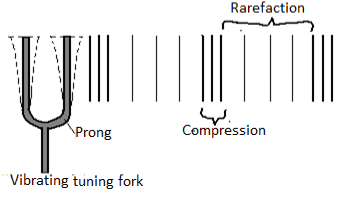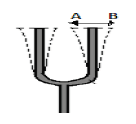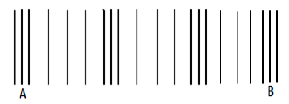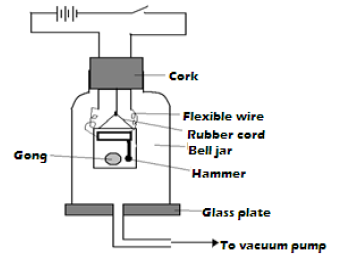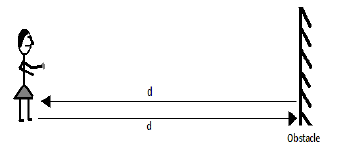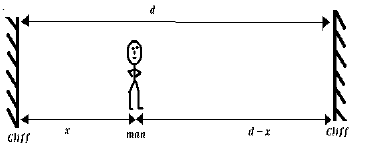- Definition of Sound
- Some Sources of Sound
- Propagation of Sound Energy
- Reflection Property of Sound Waves
- Revision Exercise

Definition of Sound
- Sound is a form of energy that originates from vibrating objects. It is a longitudinal mechanical wave.

Some Sources of Sound
- Vibrating wooden strip
- Vibrating wire e.g. guitar wire being plucked.
- Vibrating drum
- Tuningfork - the prongs of tuning fork are made to vibrate by striking them against a hard surface.
- Vibrating air columns e.g. blowing air across the mouth of a test-tube.
- Air siren- it is a form of disk with a ring of equally spaced holes which are equidistant from the centre. It is rotated at a constant rate as air is blown through the holes.
- Cog - wheel and card
- Voice box (larynx)

Propagation of Sound Energy
- Sound wave is propagated in form of compressions (areas of high pressure) and rarefactions (areas of low pressure) through propagating medium. Sound requires a material medium for propagation.
Exercise
- The figure below shows a vibrating fork. The time interval for the prong to go from A to B is 0.005s. Find:
- The frequency of the fork
- The wave length of the vibrations, if the velocity of sound in air is 340m/s.
- The diagram below shows sound waves passing through air. Study it and answer the questions that follow.
- Label the following:
- Compression
- Rarefaction
- wavelength
- If the wave front takes 0.1s to travel from A to B, find:
- The frequency
- The wavelength, if velocity of sound in air is 330m/s.
- Label the following:
Experiment
Aim: To show that sound requires a material medium to travel. (I.e.sound does not travel in vacuum)
Apparatus
- Electricbell
- Switch
- Bell glass-jar
- Vacuum pump
- Wires
- Cells
- Glassplate
Procedure
- Setup the apparatus as shown in the diagram below.
- Close the switch and observe what happens.
Observation: It is observed that the bell begins to ring and the sound is heard outside. - Gradually pumpout some air and note the effect this has on sound reaching you.
Observation: The intensity of sound decreases gradually. - Pump as much air out of the jar as possible and listen to the sound produced.
Observation: Sound is found to have almost disappeared though the hammer can be seen vibrating
Conclusion
The above observations show that the sound cannot travel through a vacuum. It needs a material medium for propagation.
Factors Affecting Velocity of Sound In Air
- Temperature of the air - sound travels faster in hot air than in cold air.
- Humidity of the air - the velocity of sound on air increases with humidity.
- Direction of wind - wind blowing in the same direction as sound increases the velocity of the latter.
Sound Transmission in Solids, Liquids and Gases
- Sound travels fastest in solids, followed by liquids and then gases.
- Speed of sound in materials varies from solid to solid, liquid to liquid and gas to gas depending on the density of the material. Denser material transmits sound faster.

Reflection Property of Sound Waves
- Reflected sound is called echo. Sound is reflected when it falls on hard surfaces.
- Reflections of sound waves also obey the laws of reflection:
- The angle of incidence is equal to the angle of reflection at point of incidence
- The incident sound, the reflected sound and the normal lie on the same plane.
Reverberation
- Reverberation refers to the effect in which original sound seems prolonged due to overlap with the echo sound. It occurs in some halls, sound waves are reflected from walls, floor and ceiling and since the echo time is short; the echo overlaps with the original sound.
- To reduce reverberation in places like broadcasting studios and concert halls, walls are made using absorbent materials like cotton wool and foam rubber.
Applications of Reflection of Sound
a) Determination of Speed of Sound
- In this case, sound is produced in front of an obstacle whose distance away is known. The time for the sound to reach the obstacle and back to the source (i.e.time for echo to be heard) is measured using a stopwatch.
Speed of sound = distance travelled, 2d/timetaken, t = 2d/t
Example
- A man standing in a valley between two cliffs strikes a gong. He hears an echo from one cliff 0.7s later and from the other 0.2s after the first. Determine the width of the valley. (Speed of sound in air,v=330ms-1)
Solution
let distance from nearest cliff be x and that between the two cliffs d
distance = speed of sound × time
∴2x=330m/s ×0.7s
x = 115.5m
Also,2(d-x)=330m/s × (0.7+0.2)s
d = 297/2 + x
d=148.5+115.5 = 264m (this is the width of the cliff) - A time keeper in 100m race stands at the finishing point. He starts his watch the moment he hears the sound of a gun. What error does he make in the timing of the race?(Speed of sound in air is 330ms-1)
Solution
The error is equal to the time taken for the sound from the gun to reach the time keeper, i.e. time taken for sound to travel 100m at the speed of 330ms-1 the sound takes:
T = 100m/330m/s = 0.303seconds
b) Determination of Distances by Producing Sound of a Known Speed(pulse-echo technique)
- Pulse-echo technique involves measuring distances by producing sound of known speed and measuring time taken to receive an echo.
- Ultrasound (sound of frequency of over 20KHz) is used in pulse-echo technique because it penetrates deepest and can be reflected easily by tiny grains.
Exercise
A fishing boat uses ultra-sound of frequency 6.0x104Hz to detect fish directly below. Two echoes of the ultra sound are received, one after 0.09s coming from the shoal of fish and other after 0.12s coming from the sea bed. If the sea bed is 84m below the ultrasound transceiver, calculate:
- The speed of ultrasound waves in water
- The wavelength o fthe ultrasound waves in water
- The depth of the shoal of fish below the boat.
Applications of Pulse-Echo Technique
Used:
- In the ship to determine the depth of the sea.
- In under water exploration of gas and oil.
- In fishing boats with pulse echo equipment to locate shoals of fish.
- In special types of spectacles used by the blind people to tell how far objects are ahead of them.
- By bats to detect the presence of obstacle is in their flight path.

Revision Exercise
- State how the pitch of sound wave is affected by frequency
- The following diagram shows a setup that was used to demonstrate that sound requires a material medium for transmission.
- State what happens to the sound from the bell as air continues to be drawn from the jar
- What happens to the sound if some air is allowed back into the jar?
- Give possible reasons why it is not possible to reduce sound completely in this experiment
- A girl standing some distance away from the cliff blows a whistle and hears an echo 1.10s later. If the speed of a sound in air is 350ms-1, determine how far the girl is from the foot of the cliff.
- A loud speaker placed between two walls but nearer to wall A than wall B is sending outc onstant sound waves.Determine how far the loud speaker is from wall B if it is 100m from wall A and the time between the two echoes received is 0.2seconds.(Speed of sound in air=340ms-1)
- In an experiment to determine speed of sound in air, a drum at a point 150m from a vertical wall was struck at varying frequency while listening to the echo. The echo coincides with the sound from the drum at a time when to successive strikes were made within a time of 18.5s.
- Determine the time taken for an echo to be heard
- Determine the speed of sound in air at the place
- What difference would you expect if the experiment was repeated on a colder day?
- A boy strikes a railway line with a hammer. A railway walker 600m away hears two sounds, one from the railway line and the other from air. If the time interval between the two sounds is 1.65s and the speed of sound in air is 340ms-1, determine the speed of sound in the railway line.
Join our whatsapp group for latest updates
Tap Here to Download for 50/-
Get on WhatsApp for 50/-
Download SOUND - Form 2 Physics Notes.
Tap Here to Download for 50/-
Get on WhatsApp for 50/-
Why download?
- ✔ To read offline at any time.
- ✔ To Print at your convenience
- ✔ Share Easily with Friends / Students
